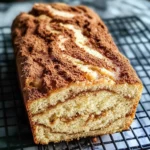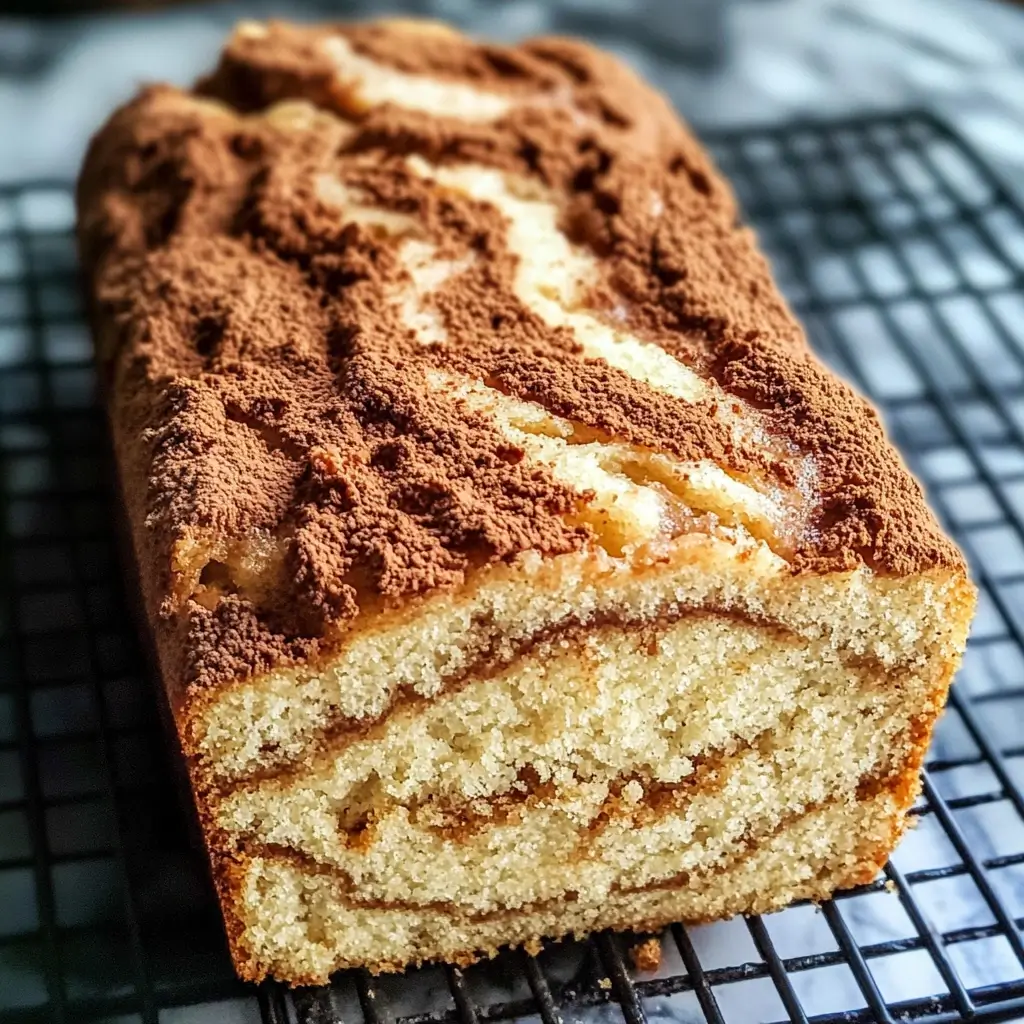Let me tell you a little secret: mornings in our house used to be a bit… chaotic. Rushing around, barely enough time for a quick bite, and definitely no time for anything truly indulgent. That was until I stumbled upon this Coffee Cake Loaf recipe. Honestly, it was a game-changer. The aroma alone, as it bakes, is enough to transform the entire house into a cozy haven. And the taste? Oh, the taste! Imagine a slice of pure comfort, a tender, moist crumb infused with warm cinnamon sweetness, melting in your mouth with every bite. My family devoured it in record time, and it’s now become a weekend staple. Even my pickiest eater, who usually shuns anything remotely “cakey” for breakfast, asks for seconds (and thirds!). If you’re looking for a simple yet utterly delightful treat to brighten your mornings, or any time of day really, look no further. This Coffee Cake Loaf is about to become your new favorite too.
Ingredients
This recipe uses simple pantry staples, making it easy to whip up whenever the craving strikes. Let’s break down each ingredient and why it plays a crucial role in creating the perfect Coffee Cake Loaf.
For the Cinnamon Sugar Swirl:
- ½ cup brown sugar (packed): Brown sugar is the heart of that irresistible cinnamon swirl. The molasses in brown sugar adds a depth of flavor and moisture that granulated sugar simply can’t replicate. Packing it ensures you get the right amount for that rich, gooey center.
- 2 teaspoons cinnamon (ground): Cinnamon is the star of the show, lending its warm, comforting aroma and flavor to both the swirl and the cake itself. Ground cinnamon is readily available and blends seamlessly into the sugar mixture.
For the Coffee Cake Loaf:
- 2 cups all-purpose flour: All-purpose flour provides the structure for our loaf. It has a moderate protein content, which results in a tender yet sturdy crumb. Make sure to measure it correctly – spooning it into your measuring cup and leveling it off is the best way to avoid using too much flour, which can lead to a dry cake.
- 1 tablespoon baking powder: Baking powder is a chemical leavening agent that creates lift and lightness in the cake. It’s essential for achieving that airy, tender crumb we’re after. Make sure your baking powder is fresh for optimal results.
- 1 teaspoon baking soda: Baking soda is another leavening agent, and it also reacts with the buttermilk in the recipe to create a slightly tangy flavor and contribute to the cake’s moistness. Like baking powder, ensure it’s fresh for the best rise.
- ¼ teaspoon salt: Salt might seem insignificant, but it’s crucial for balancing the sweetness and enhancing the other flavors in the cake. It prevents the cake from tasting flat and brings out the richness of the butter and vanilla.
- ¼ cup butter (unsalted, softened): Unsalted butter allows you to control the overall saltiness of the recipe. Softened butter is essential for proper creaming with the sugar, creating a light and airy base for the cake. Make sure it’s truly softened, but not melted, for the best texture.
- ¾ cup sugar (granulated): Granulated sugar provides sweetness and also contributes to the cake’s texture. When creamed with butter, it creates air pockets that help the cake rise and become light and fluffy.
- 2 large eggs (room temperature): Eggs add richness, moisture, and structure to the cake. Using room temperature eggs is important because they emulsify more easily with the other ingredients, resulting in a smoother batter and a more even texture in the baked loaf.
- 1 cup buttermilk: Buttermilk is the secret ingredient for a truly moist and tender coffee cake. Its acidity reacts with the baking soda, creating a tender crumb and a slight tang that complements the sweetness perfectly. If you don’t have buttermilk, you can make a quick substitute (see FAQ section!).
- 1 teaspoon vanilla extract: Vanilla extract enhances the overall flavor profile of the cake, adding a warm, comforting note that ties everything together. Use pure vanilla extract for the best flavor, or vanilla bean paste for an even richer vanilla experience.
Metric Conversion:
- Brown sugar: 100g
- Cinnamon: 8g
- All-purpose flour: 250g
- Baking powder: 15ml
- Baking soda: 5ml
- Salt: 1.5g
- Butter: 57g
- Granulated sugar: 150g
- Eggs: Approximately 100g (without shell)
- Buttermilk: 240ml
- Vanilla extract: 5ml
Instructions
Let’s walk through the step-by-step process of creating this delicious Coffee Cake Loaf. Don’t be intimidated – it’s easier than you think! Follow these instructions, and you’ll be enjoying a warm slice in no time.
Step 1: Preheat and Prepare
Begin by preheating your oven to 350°F (175°C). This is crucial for ensuring even baking. While the oven is heating, prepare your loaf pan. A standard 9×5 inch loaf pan works perfectly. You have two options for preparing the pan:
- Cooking Spray: A quick and easy method. Spray the inside of the loaf pan generously with non-stick cooking spray, ensuring you reach all corners and sides. This will help the loaf release easily after baking.
- Greasing with Butter and Flour: For a more traditional approach, grease the pan with softened butter, ensuring every surface is coated. Then, lightly dust the greased pan with all-purpose flour, tapping out any excess. This method creates a slightly crisper crust on the loaf.
Choose whichever method you prefer – both work effectively to prevent sticking.
Step 2: Make the Cinnamon Sugar Swirl
In a medium-sized bowl, combine the packed brown sugar and ground cinnamon. Use a whisk or a fork to thoroughly combine the two ingredients until the cinnamon is evenly distributed throughout the brown sugar. Break up any clumps of brown sugar to ensure a smooth mixture. Set this bowl aside – this is your magical cinnamon swirl that will create those delightful ribbons of flavor in your coffee cake.
Step 3: Combine Dry Ingredients
In a separate, larger bowl, whisk together the all-purpose flour, baking powder, baking soda, and salt. Whisking is important here to ensure that the leavening agents (baking powder and baking soda) and salt are evenly dispersed throughout the flour. This prevents pockets of baking powder or soda in the cake, which can lead to uneven rising or a metallic taste. Set this bowl of dry ingredients aside.
Step 4: Cream Butter and Sugar
In another large bowl (or the bowl of your stand mixer, if using), add the softened unsalted butter and granulated sugar. Using an electric mixer (handheld or stand mixer) fitted with the paddle attachment, cream together the butter and sugar on medium speed until the mixture becomes light and fluffy. This process should take about 2-3 minutes. You’ll notice the color of the mixture lighten as air is incorporated. Proper creaming is essential for creating a tender and airy cake. Scrape down the sides of the bowl occasionally with a spatula to ensure everything is evenly combined.
Step 5: Add Eggs
Once the butter and sugar are creamed, add the room temperature eggs one at a time to the bowl. Beat well after each addition, ensuring each egg is fully incorporated into the butter-sugar mixture before adding the next. Continue mixing until the mixture is light and fluffy, and slightly pale in color. This step also contributes to the cake’s structure and richness. Again, scrape down the sides of the bowl as needed.
Step 6: Incorporate Wet and Dry Ingredients
Now it’s time to bring everything together. In a small bowl, whisk together the buttermilk and vanilla extract. This ensures the vanilla is evenly distributed throughout the buttermilk.
Gradually add the dry ingredients (flour mixture) to the wet ingredients (butter-sugar-egg mixture) in alternating additions with the buttermilk mixture. Begin by adding about one-third of the dry ingredients to the bowl and mix on low speed until just combined. Then, add half of the buttermilk mixture and mix until just combined. Repeat with another third of the dry ingredients, the remaining buttermilk, and finally, the last third of the dry ingredients. Mix until everything is just incorporated and smooth.
Important Note about Batter Consistency: The batter for this coffee cake loaf is intentionally a bit thicker than a regular cake batter. This helps to hold the cinnamon sugar layers in place during baking. However, if your batter seems excessively thick, you can add a tablespoon or two of additional buttermilk to loosen it slightly. Conversely, if your batter appears too thin, you can add a tablespoon or two of extra flour to thicken it. The goal is a smooth, pourable batter that is not too runny and not too stiff.
Step 7: Layer Batter and Cinnamon Sugar
Pour approximately one-third of the coffee cake batter into the prepared loaf pan, spreading it evenly across the bottom. Sprinkle one-third of the cinnamon sugar mixture evenly over the batter layer. Repeat this process two more times: pour another third of the batter over the cinnamon sugar, sprinkle with another third of the cinnamon sugar, and finally, pour the remaining batter over the second cinnamon sugar layer and top with the remaining cinnamon sugar mixture. You should end up with three layers of batter and three layers of cinnamon sugar, with the final layer being cinnamon sugar on top.
Step 8: Bake to Golden Perfection
Transfer the loaf pan to the preheated oven and bake for 50 minutes to 1 hour, or until a toothpick inserted into the center of the loaf comes out clean. Baking times can vary slightly depending on your oven, so it’s always best to check for doneness using the toothpick test. The top of the loaf should be golden brown and spring back lightly when gently pressed.
Step 9: Cool and Enjoy
Once baked, remove the loaf pan from the oven and let it cool in the pan for 5 minutes. This allows the cake to firm up slightly, making it easier to remove from the pan. After 5 minutes, gently invert the loaf onto a wire rack to finish cooling completely. Cooling on a wire rack allows air to circulate around the loaf, preventing the bottom from becoming soggy.
While the loaf is still slightly warm, it’s absolutely divine! Slice and serve it up with a hot cup of coffee or tea for the perfect morning or afternoon treat. The warm cinnamon sugar swirl will be beautifully melted and gooey, and the tender crumb will practically melt in your mouth.
Nutrition Facts
This recipe yields approximately 10 servings. Nutritional information is an estimate and can vary based on specific ingredients used and serving sizes.
Serving Size: 1 slice (approximately 1/10th of the loaf)
Calories per serving (estimated): 320-380 calories
Approximate Breakdown per Serving:
- Fat: 15-20g
- Saturated Fat: 8-12g
- Cholesterol: 70-90mg
- Sodium: 250-300mg
- Carbohydrates: 40-50g
- Sugar: 20-25g
- Protein: 4-5g
Important Note: This coffee cake loaf is a treat and is higher in calories, fat, and sugar. Enjoy it in moderation as part of a balanced diet.
Preparation Time
This recipe is relatively quick to prepare, making it perfect for busy mornings or when you need a delicious treat without spending hours in the kitchen.
- Prep Time: 15 minutes
- Cook Time: 1 hour
- Total Time: 1 hour 15 minutes
The majority of the time is spent baking, allowing you to multitask or relax while the aroma of cinnamon fills your home. The active prep time is minimal, involving mostly mixing ingredients, making it a beginner-friendly recipe.
How to Serve
This Coffee Cake Loaf is incredibly versatile and can be enjoyed in numerous ways. Here are some delicious serving suggestions:
- Classic Coffee Companion: As the name suggests, this loaf is the perfect partner for a hot cup of coffee. The warm cinnamon and sweet cake complement the bitterness of coffee beautifully.
- Tea Time Treat: Equally delightful with a cup of tea, whether it’s black tea, green tea, or herbal tea. The loaf’s sweetness balances the subtle flavors of tea.
- Warm and Toasted: For an extra layer of indulgence, try toasting a slice of coffee cake loaf and spreading it with a little butter. The toasting enhances the texture and brings out the cinnamon flavor even more.
- Dessert with a Dollop: Elevate this loaf to dessert status by serving it warm with a scoop of vanilla ice cream or a dollop of whipped cream. The contrast of warm cake and cold ice cream is heavenly.
- Brunch Centerpiece: This loaf makes a beautiful and delicious centerpiece for a brunch spread. Slice it and arrange it on a platter alongside fresh fruit, yogurt, and other brunch favorites.
- Midday Snack: Perfect for a satisfying midday snack to curb sweet cravings. A slice of coffee cake loaf provides a comforting and energy-boosting treat.
- Holiday Baking: This loaf is a wonderful addition to holiday baking. Its warm spices and comforting flavors make it a perfect treat for fall and winter gatherings.
Additional Tips for Baking the Perfect Coffee Cake Loaf
Want to ensure your Coffee Cake Loaf is absolutely perfect every time? Here are five essential tips to keep in mind:
- Room Temperature Ingredients are Key: Using room temperature butter and eggs is crucial for proper emulsification and a smooth batter. Room temperature ingredients blend together more easily, creating a lighter and more even texture in the baked loaf. Take your butter and eggs out of the refrigerator at least 30 minutes before you start baking.
- Don’t Overmix the Batter: Overmixing the batter can develop the gluten in the flour, resulting in a tough and dense cake. Mix the dry and wet ingredients until just combined and smooth. A few streaks of flour are okay – they will disappear during baking.
- Measure Flour Accurately: Too much flour can lead to a dry and crumbly cake. The best way to measure flour is to spoon it into your measuring cup and level it off with a straight edge. Avoid scooping flour directly from the bag, as this can pack it down and result in using too much flour.
- Let it Cool Completely (Almost): While it’s tempting to slice into the loaf immediately, allowing it to cool in the pan for 5 minutes and then on a wire rack for further cooling is important. This allows the cake to set properly and prevents it from crumbling when sliced. However, it’s also best enjoyed slightly warm for the ultimate melt-in-your-mouth experience!
- Store Properly to Maintain Freshness: To keep your Coffee Cake Loaf moist and delicious, store it in an airtight container at room temperature for up to 3-4 days. For longer storage, you can freeze slices or the whole loaf (see FAQ section!).
Frequently Asked Questions (FAQ)
Have questions about making this Coffee Cake Loaf? Here are answers to some common queries:
Q1: Can I make this recipe ahead of time?
A: Absolutely! Coffee Cake Loaf is a great make-ahead treat. You can bake it a day or two in advance and store it at room temperature in an airtight container. The flavors actually meld and deepen overnight.
Q2: Can I freeze Coffee Cake Loaf?
A: Yes, you can freeze it for longer storage. Allow the loaf to cool completely, then wrap it tightly in plastic wrap and then in aluminum foil. Freeze for up to 2-3 months. To thaw, simply let it sit at room temperature for a few hours or overnight. You can also freeze individual slices for easy grab-and-go snacks.
Q3: I don’t have buttermilk. Can I substitute anything else?
A: Yes, you can make a quick buttermilk substitute. For 1 cup of buttermilk, combine 1 tablespoon of lemon juice or white vinegar with enough milk to measure 1 cup. Stir and let it sit for 5 minutes to thicken slightly before using in the recipe. Plain yogurt or sour cream, thinned with a little milk, can also be used as substitutes.
Q4: Can I add nuts or other toppings to this recipe?
A: Definitely! Feel free to customize your Coffee Cake Loaf. Chopped pecans or walnuts can be added to the cinnamon sugar swirl or sprinkled on top before baking for added crunch and flavor. You could also add a simple glaze after baking. A powdered sugar glaze or a cream cheese glaze would both be delicious additions.
Q5: My coffee cake is sinking in the middle. What did I do wrong?
A: There are a few potential reasons for a sunken coffee cake. Overmixing the batter, using too much leavening agent (baking powder/soda), or opening the oven door too frequently during baking can all contribute to sinking. Ensure you are measuring ingredients accurately, mixing just until combined, and avoiding opening the oven door unnecessarily during the first 30-40 minutes of baking. Also, ensure your oven temperature is accurate, as an oven that is too hot can cause the cake to rise too quickly and then collapse.
This Coffee Cake Loaf is more than just a recipe; it’s an invitation to slow down, savor the simple moments, and enjoy the comforting flavors of home baking. So, preheat your oven, gather your ingredients, and get ready to create a loaf of pure deliciousness that will become a cherished favorite in your kitchen too. Don’t forget to leave a review and rating once you’ve tried it – your feedback helps us continue sharing free and wonderful recipes! Happy baking!
Print
Coffee Cake Loaf Recipe
Ingredients
For the Cinnamon Sugar Swirl:
- ½ cup brown sugar (packed): Brown sugar is the heart of that irresistible cinnamon swirl. The molasses in brown sugar adds a depth of flavor and moisture that granulated sugar simply can’t replicate. Packing it ensures you get the right amount for that rich, gooey center.
- 2 teaspoons cinnamon (ground): Cinnamon is the star of the show, lending its warm, comforting aroma and flavor to both the swirl and the cake itself. Ground cinnamon is readily available and blends seamlessly into the sugar mixture.
For the Coffee Cake Loaf:
- 2 cups all-purpose flour: All-purpose flour provides the structure for our loaf. It has a moderate protein content, which results in a tender yet sturdy crumb. Make sure to measure it correctly – spooning it into your measuring cup and leveling it off is the best way to avoid using too much flour, which can lead to a dry cake.
- 1 tablespoon baking powder: Baking powder is a chemical leavening agent that creates lift and lightness in the cake. It’s essential for achieving that airy, tender crumb we’re after. Make sure your baking powder is fresh for optimal results.
- 1 teaspoon baking soda: Baking soda is another leavening agent, and it also reacts with the buttermilk in the recipe to create a slightly tangy flavor and contribute to the cake’s moistness. Like baking powder, ensure it’s fresh for the best rise.
- ¼ teaspoon salt: Salt might seem insignificant, but it’s crucial for balancing the sweetness and enhancing the other flavors in the cake. It prevents the cake from tasting flat and brings out the richness of the butter and vanilla.
- ¼ cup butter (unsalted, softened): Unsalted butter allows you to control the overall saltiness of the recipe. Softened butter is essential for proper creaming with the sugar, creating a light and airy base for the cake. Make sure it’s truly softened, but not melted, for the best texture.
- ¾ cup sugar (granulated): Granulated sugar provides sweetness and also contributes to the cake’s texture. When creamed with butter, it creates air pockets that help the cake rise and become light and fluffy.
- 2 large eggs (room temperature): Eggs add richness, moisture, and structure to the cake. Using room temperature eggs is important because they emulsify more easily with the other ingredients, resulting in a smoother batter and a more even texture in the baked loaf.
- 1 cup buttermilk: Buttermilk is the secret ingredient for a truly moist and tender coffee cake. Its acidity reacts with the baking soda, creating a tender crumb and a slight tang that complements the sweetness perfectly. If you don’t have buttermilk, you can make a quick substitute (see FAQ section!).
- 1 teaspoon vanilla extract: Vanilla extract enhances the overall flavor profile of the cake, adding a warm, comforting note that ties everything together. Use pure vanilla extract for the best flavor, or vanilla bean paste for an even richer vanilla experience.
Instructions
For the Cinnamon Sugar Swirl:
- ½ cup brown sugar (packed): Brown sugar is the heart of that irresistible cinnamon swirl. The molasses in brown sugar adds a depth of flavor and moisture that granulated sugar simply can’t replicate. Packing it ensures you get the right amount for that rich, gooey center.
- 2 teaspoons cinnamon (ground): Cinnamon is the star of the show, lending its warm, comforting aroma and flavor to both the swirl and the cake itself. Ground cinnamon is readily available and blends seamlessly into the sugar mixture.
For the Coffee Cake Loaf:
- 2 cups all-purpose flour: All-purpose flour provides the structure for our loaf. It has a moderate protein content, which results in a tender yet sturdy crumb. Make sure to measure it correctly – spooning it into your measuring cup and leveling it off is the best way to avoid using too much flour, which can lead to a dry cake.
- 1 tablespoon baking powder: Baking powder is a chemical leavening agent that creates lift and lightness in the cake. It’s essential for achieving that airy, tender crumb we’re after. Make sure your baking powder is fresh for optimal results.
- 1 teaspoon baking soda: Baking soda is another leavening agent, and it also reacts with the buttermilk in the recipe to create a slightly tangy flavor and contribute to the cake’s moistness. Like baking powder, ensure it’s fresh for the best rise.
- ¼ teaspoon salt: Salt might seem insignificant, but it’s crucial for balancing the sweetness and enhancing the other flavors in the cake. It prevents the cake from tasting flat and brings out the richness of the butter and vanilla.
- ¼ cup butter (unsalted, softened): Unsalted butter allows you to control the overall saltiness of the recipe. Softened butter is essential for proper creaming with the sugar, creating a light and airy base for the cake. Make sure it’s truly softened, but not melted, for the best texture.
- ¾ cup sugar (granulated): Granulated sugar provides sweetness and also contributes to the cake’s texture. When creamed with butter, it creates air pockets that help the cake rise and become light and fluffy.
- 2 large eggs (room temperature): Eggs add richness, moisture, and structure to the cake. Using room temperature eggs is important because they emulsify more easily with the other ingredients, resulting in a smoother batter and a more even texture in the baked loaf.
- 1 cup buttermilk: Buttermilk is the secret ingredient for a truly moist and tender coffee cake. Its acidity reacts with the baking soda, creating a tender crumb and a slight tang that complements the sweetness perfectly. If you don’t have buttermilk, you can make a quick substitute (see FAQ section!).
- 1 teaspoon vanilla extract: Vanilla extract enhances the overall flavor profile of the cake, adding a warm, comforting note that ties everything together. Use pure vanilla extract for the best flavor, or vanilla bean paste for an even richer vanilla experience.
Nutrition
- Serving Size: One Normal Portion
- Calories: 320-380
- Sugar: 20-25g
- Sodium: 250-300mg
- Fat: 15-20g
- Saturated Fat: 8-12g
- Carbohydrates: 40-50g
- Protein: 4-5g
- Cholesterol: 70-90mg





